DailyDx: What's your Diagnosis of this Female Patient?
This case is of a young married female patient of 25 years age. She presented with bleeding per vagina and mild pain in the right side of the pelvis.
What's your Diagnosis of this Female Patient?
History:
This case is of a young married female patient of 25 years age. She presented with bleeding per vagina and mild pain in the right side of the pelvis. She has no previous history of pregnancy. Her last menstrual period was 6 weeks before the date of ultrasound study (6 weeks amenorrhea). She had normal 30 day menstrual cycles, with the menses lasting 2 to 3 days.
Family History:
She was the 2nd child of a family of 3 children and she has had no previous history of conception.
Clinical Examination:
The patient had mild tenderness over the right iliac fossa and right hemipelvis. Her vital signs were normal. Pulse: 72/ minute. B.P.: 118 / 78 mm.
Sonography of the Pelvis
Transabdominal ultrasound of pelvis
Image 1: Uterus in transverse and sagittal sections
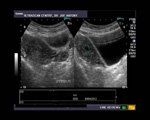
Image 2: Uterus- sagittal section
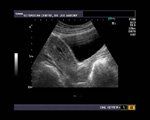
Do you want to see more images?
If you think you know what this is, add your comment below.
Ultrasound findings:
What are your findings? The uterus appears mildly enlarged with a fluid collection within the endometrial cavity. Is this an intrauterine gestation sac? The walls of the sac like structure appear thin walled and are definitely not echogenic, as should be seen in a normal intrauterine gestation. There is also a small cystic structure in the left ovary. The right adnexal region is poorly visualized in these images.
Is this a case of non viable intrauterine pregnancy? Is this an anembryonic gestation? Perhaps, the 2nd image tells us more. An anembryonic gestation should show a round gestation sac in the uterus. Here the sac like structure is elongated and tapers down towards the lower part of the uterus. What pathology would produce such an appearance?Shall we see the transvaginal images of the pelvis?
Image 3: Transvaginal image of uterus
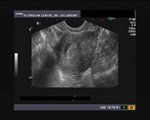
Image 4: Right adnexal region
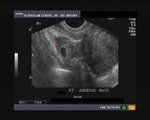
Image 5: Color Doppler image of right adnexal region
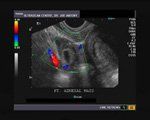
What is your Diagnosis?
The transvaginal images cast light on more pathology than was obvious in the transabdominal images of the uterus. The uterine fluid collection is obviously is not a gestation sac. In addition there is a right adnexal cystic structure. Is this a corpus luteal cyst? No; the cyst was seen to move separately from the right ovary on pressure with the transducer. In addition, note that the right cystic mass is thick walled and has echogenic walls. This appearance is more like that of a gestation sac rather than a luteal cyst. What pathology would produce a sac outside the uterine cavity? (Note also that the patient has pain in the right side of the pelvis). There is surprisingly, no fluid in the cul-de-sac.
What's the final diagnosis?
Want to stump your colleagues in the DailyDx? Send us your images and diagnoses.
Final Diagnosis:
Clearly, the imaging findings point to an ectopic gestation in the right adnexal region. This is a right tubal ectopic gestation. The only findings that do not favor a diagnosis of ectopic pregnancy are lack of fluid in the pelvis and also the absence of the “ring of fire” sign on color Doppler imaging of the right adnexal cystic lesion. The points in favor of the diagnosis are:
• the presence of a right adnexal cystic lesion with echogenic
• thick walls (the tubal ring sign)
• and also the pseudosac in the uterine cavity
Real time ultrasonography proved that the adnexal cystic mass was separate from the right ovary. However, we could not find a yolk sac inside the right tubal ectopic pregnancy.
Differential Diagnosis:
The following are the main conditions that may mimic an ectopic pregnancy
1) Missed abortion (anembryonic gestation)
2) Corpus luteal cyst
3) Hemorrhagic cyst
4) Decidual cyst in intrauterine pregnancy
5) Molar pregnancy
Anembryonic Intrauterine Gestation, the typical appearance would be a round sac within the uterine cavity. In addition, in ectopic gestation, the pseudosac in the uterus will be seen to be tapering towards the cervix.
Corpus luteal cysts and hemorrhagic cysts are pathologies that may mimic a tubal ectopic pregnancy. However, these are not associated with uterine changes such as a pseudosac. The presence of multiple adhesions or septae within the luteal cyst gives an indication of their benign nature. In addition, the identification of the ovary separately from the cystic mass helps to differentiate these cysts from ectopic/ tubal gestation.
Decidual cysts are often seen in normal early pregnancies and are usually multiple in nature. These are always thin walled and not associated with adnexal masses.
Molar pregnancies have typical features like the snowstorm or bunch of grapes appearance and can be easily identified on sonography of the uterus.
Discussion:
Ectopic gestations amount to almost 2 % of all pregnancies and are a major cause of maternal mortality in the first trimester. It is defined as the implantation of a blastocyst outside the endometrium of the uterus. The mortality rate due to ectopic pregnancy is as high as 9 to 14 %.
The commonest location of ectopic pregnancy is the ampullary- in the ampulla of the Fallopian Tube.
Other less common sites of ectopic gestation are:
1) Isthmus- in the isthmus of the Fallopian tube
2) Interstitial- in the intramyometrial segment of the Fallopian tube
3) Cornual- in one of the horns or cornu of the bicornuate uterus
4) Ovarian – in the ovary
5) Cervical pregnancy- inside the cervix of uterus
6) Scar pregnancy- within the LSCS scar
7) Intra-abdominal pregnancy - within the peritoneal cavity
Add your comments below!
Want to stump your colleagues in the DailyDx? Send us your images and diagnoses.
References:
References:
1) Diagnostic ultrasound- Carol Rumack- 2nd edition
2) Ultrasonography in obstetrics and gynecology- Callen- 3rd edition
3) Diagnostic clues to Ectopic pregnancy (radiographics article)
4) Ectopic pregnancy - RSNA- Radiology
5 Article on ectopic pregnancy (www.ultrasound-images.com)
S1E4: Dr. Kristina Adams-Waldorf: Pandemics, pathogens and perseverance
July 16th 2020This episode of Pap Talk by Contemporary OB/GYN features an interview with Dr. Kristina Adams-Waldorf, Professor in the Department of Obstetrics and Gynecology and Adjunct Professor in Global Health at the University of Washington (UW) School of Medicine in Seattle.
Listen
Similar delivery times between misoprostol dosages among obese patients reported
May 29th 2024A recent study found that obese patients undergoing induction of labor experienced similar delivery times regardless of whether they received 50 μg or 25 μg of vaginal misoprostol, though multiparous patients showed faster delivery with the higher dosage.
Read More
